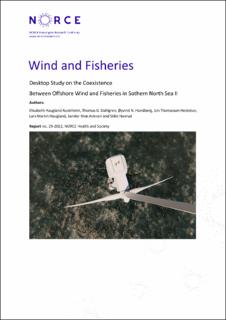| dc.description.abstract | The Norwegian Government has launched a major initiative to promote offshore wind power , in which bottom-fixed wind power will be developed in the Southern North Sea II (SN II) area. There is a low level of fishing activities in this area with varying catch sizes over the years. The activities consist nearly exclusively of bottom trawling of sandeel. The fishing industry has raised concerns about the development of offshore wind farms (OWFs), including risks for collision and hindrance for fishing vessels, negative impacts on fish stocks, and other ecosystem-wide effects. This report has conducted a data study and compiled existing literature on these topics to, based on best available science, assess how OWF development could affect fisheries in SN II, the possibilities for facilitating coexistence for these two industries, and potential synergies. While the development of OWFs in SN II has the potential to bring both positive and negative effects on the fisheries as well as the marine life in the area, the findings suggest that coexistence between the two industries is possible. Potential impacts, including noise, magnetic fields, turbidity, artificial reef and FAD effects, and no-fishing zones, have not been shown to adversely affect populations of commercially important fish at OWF developments in the North Sea. With the ongoing technology shift to larger turbines, the space between each turbine is increasing, which may reduce collision risk. Seafloor cables can also be sufficiently buried to reduce the risk of damage by demersal trawls. Furthermore, most types of passive fishing gear (except for drifting nets) and practices are less problematic to use in an OWF. Should, though, the construction of OWFs in SN II cause restrictions on the fishery activities in the area, it is likely to cause increased fishing in other areas, often referred to in the scientific literature as the displacement effect, indicating that the economic loss will be smaller than the estimated catch values. Notable knowledge gaps are regarding positive and negative long term cumulative impacts and regional effects, impact on primary production and carbon assimilation from changed upper ocean mixing and impact from floating wind farms (not relevant in SN II). We emphasise the importance of early and ongoing input from relevant stakeholders to address concerns and find optimal mitigation measures for minimising the OWF footprint in SN II during the different phases of OWF development. | |

